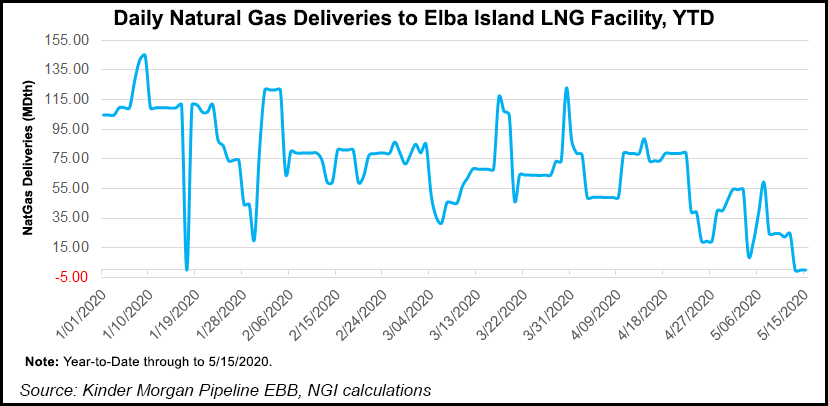NGI The Weekly Gas Market Report | Infrastructure | LNG | LNG Insight | NGI All News Access
Fire at Elba Island LNG Shuts Down Three Units, Cuts Feed Gas Deliveries
Kinder Morgan Inc. has confirmed that a fire broke out May 11 in a mixed refrigerant compressor at its Elba Island liquefied natural gas (LNG) facility in Georgia, forcing it to shut down three liquefaction units that remain offline.

The fire erupted in a compressor of the facility’s Unit 2 movable modular liquefaction system (MMLS), one of six in operation at the plant. Spokesperson Melissa Ruiz said the incident was isolated to Unit 2 and the fire was extinguished by equipment on site. There were no injuries.
The company shut down Units 1 and 3, which are near Unit 2, Ruiz added. The other three units remain in operation. “All of the appropriate regulatory agencies have been notified and an investigation into the cause of the fire is underway,” she said. “Restart plans are in development on these units.”
Ruiz also said that Unit 8 was shut down this week in order to complete maintenance work commonly related to the commissioning process. Feed gas was introduced to the unit earlier this month, and it is one of four remaining liquefaction units that are expected to come online this summer.
The outages at Elba come at a time when feed gas deliveries to U.S. export facilities have dropped significantly to levels below 6 Bcf in recent days. That’s down from highs of 9 Bcf/d earlier in the year as global gas prices plummet and pressure the economics of shipping U.S. LNG overseas.
NGI’s U.S. LNG Export Tracker shows that feed gas deliveries have declined significantly at Elba this week, with pipeline flows into the facility at just 84 Mcf on Friday. But Elba is unique in that it uses Royal Dutch Shell plc’s MMLS technology, smaller units that can be disassembled quickly and moved.
Each unit has a liquefaction capacity of just 0.3 million metric tons/year, compared to standard liquefaction trains at other export facilities that typically have a 4 mmty capacity.
NGI’s Patrick Rau, director of strategy and research, estimated that it takes Elba about 10 days with all units running at 100% capacity to produce enough LNG to fill a cargo, or in other words, the terminal has the ability to fill about three cargoes per month. Elba’s first LNG cargo left late last year.
By comparison, the largest U.S. export facility, Cheniere Energy Inc.’s Sabine Pass terminal in Louisiana, has enough capacity to produce one cargo per day.
Moreover, Shell holds 100% of Elba’s liquefaction capacity under its tolling agreement with the terminal.
“Damage to Elba Island is much less disruptive to the overall market,” Rau said, adding that fewer caroges, and only one capacity holder aren’t likely to unsettle things too much following any disruption to operations.
© 2024 Natural Gas Intelligence. All rights reserved.
ISSN © 1532-1231 | ISSN © 2577-9877 | ISSN © 1532-1266 |
